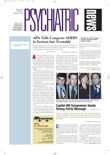How do you govern an organization of more than 37,000 psychiatrists? In coming up with an answer, keep in mind that these psychiatrists are of diverse backgrounds, ethnicities, and political perspectives; practice in different venues; and may have substantially varying orientations toward their clinical work. Moreover, the organization to which they belong must not only represent their views to the outside world, but also must serve their educational and affiliative needs and set ethical and clinical guidelines for their professional behavior. Did I mention that it has nearly a $55 million budget and is the largest publisher of psychiatric books in the world?
There you have a thumbnail sketch of the challenge we face in crafting a structure to govern our Association. To date, we have responded to the challenge with a bipartite governance arrangement. The ultimate policy-setting body with fiduciary responsibility is the Board of Trustees, with 21 voting members and a roughly equal number of nonvoting participants who sit at the Board table. At its four working meetings each year (there is also a largely ceremonial session that takes place each May at the APA annual meeting), the Board approves and monitors APA’s budget, reviews the products generated by the Association’s components (for example, position statements, resource documents, practice guidelines), and sets the directions for the work of the APA staff.
Although it is the functioning of the Board on which I particularly want to focus in this column, it is worth noting the other body that plays a key role in APA’s governance structure. The approximately 260-member APA Assembly, with representatives elected from every district branch, meets twice a year to initiate and deliberate on the policies and directions of the Association. Action papers passed by the Assembly can ultimately make their way to the Board for adoption as APA policy. Assembly members also belong to the Area Councils, organized geographically, that meet biannually to prepare for the Assembly’s meetings. I will have more to say about the structure and function of the Assembly in a subsequent column.
Overall, I think the Board does a remarkably good job of overseeing APA operations. But we ought always to be ready to ask whether it could do its job even better and—in these times of fiscal stringency for APA—whether it could do its job more efficiently. This is precisely the question that was posed at the September Board meeting. The Long-Range Budget and Planning Task Force of the Board, which I have been privileged to chair, looked closely at the structure of the Board and made recommendations for significant changes.
The task force’s report to the Board began with the observation that Board meetings involve an extraordinarily large number of people. Researchers on group interaction have demonstrated that the optimal size of any decision-making body is eight to 12 members. (It is no accident that juries, entrusted with decisions of extraordinary consequence, are composed of 12 jurors.) Many of our largest corporations have boards of this size, overseeing operations larger than APA’s by two to three orders of magnitude. Larger boards limit the time available for members to participate in deliberations and the back-and-forth discussion that can be fruitful in addressing complex problems. Decisions regarding those issues on which all members feel compelled to comment can take an unreasonably long time.
How then did APA arrive at the situation where we have 21 elected board members and a roughly equal number of other participants? For the best of reasons—I think—even if the end result is problematic. To make sure that all segments of our profession are represented, the voting Board consists of six officers, seven Area Trustees, three Trustees-at-Large (with one slot reserved for an early career psychiatrist), the three most recent past presidents, a member-in-training trustee, and the speaker of the Assembly. On the Board as nonvoting members are the member-in-training trustee-elect and certain past presidents. Alone among organizations, we have considered past presidents to be nonvoting members of the Board for life and have paid for them to attend meetings and sit at the Board table; two years ago our members agreed to end the practice prospectively, but all presidents who assumed office prior to 2001 are still entitled to attend Board meetings in perpetuity. Also around the table, also without a vote, are four additional resident representatives, a representative from the Committee of Black Psychiatrists, and the speaker-elect of the Assembly.
Our task force recommended a number of changes designed to make the Board more functional and more efficient by reducing its size. We suggested reducing voting members to 17 by cutting two past presidents (keeping only the immediate past president), eliminating one of our two vice presidents, and combining the positions of secretary and treasurer. While acknowledging the wisdom that many past presidents contribute to Board discussions, the task force recommended ending the practice of retaining them on the Board as nonvoting members. And we suggested that only voting members actually sit at the Board table, a practice common to most governing boards.
After extended discussion, the Board took what I consider to be several steps in the right direction. The second vice-president post was eliminated, and a secretary-treasurer will replace the two positions that exist now. At its next meeting, the Board will experiment with seating only voting members at the Board table, arranging nonvoting members and guests in an outer ring. But the Board voted not to change any of the practices with regard to past presidents.
This is the first time that the APA Board has decreased in size—no easy task for any group—and even if I believe we didn’t go far enough, I think the Board deserves credit for moving in the right direction. To become effective, the changes will need to be approved through the bylaws’ amendment process and then phased in over the next several years.
As we cope with serious challenges to our abilities to treat our patients, we need to be as lean and functional an organization as possible. With our component structure reshaped last spring, cutting its cost in half and emphasizing electronic and telephonic communication, and with substantial cuts to be made in the coming fiscal year in our budget for staff, we are taking the steps to do the job our members expect of us. Now the Board has followed suit.
In a later column, I will tell you about a proposal to reshape the Assembly into a more effective deliberative body. ▪

